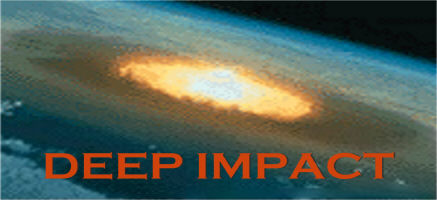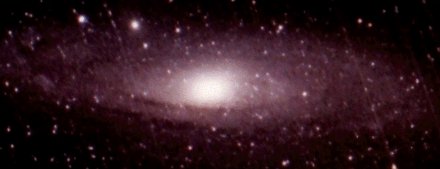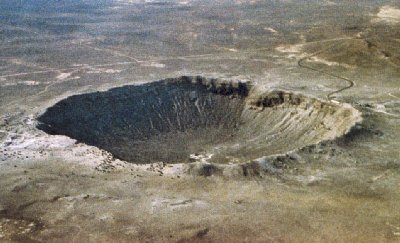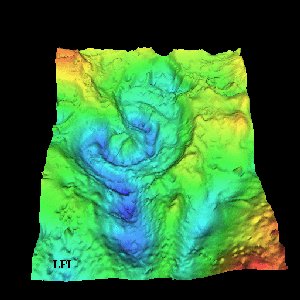|
|
|

It was this information which sent ripples through the scientific community, and many people in the government, and also general poplulation, waking them up to the reality that a cataclysmic collision could accur. Even though it was later discovered that the asteroid XF11 actually posed little threat, it made many people become aware that the Earth is just a sitting duck in the shooting gallery of space.
About four and half billion years ago, our solar system was one big huge cloud of gases, ice, iron, and rocks, which was slowly moving together under the influence of gravity. As the material compressed together in the center to form are sun, the surrounding gas and rocks started to form into other separate lumps. It was from these that our solar system was formed, with the central mass forming the sun and the separate lumps forming the planets which would encircle the sun. How-ever, there was some material left over, which formed the comets and asteroids which threaten and amaze us today.

Asteroids can be put into two separate classes, the big asteroids and the small meteorites. Meteorites are very common and cause little worry among scientist, about 50 000 collide with the earth every year, most burning up in the atmosphere. How-ever, it is the big asteroids that cause the most devastation and which worry most scientists. There is band of asteroids named the asteroid belt which contains many huge asteroids, some being miles in diameter. This belt is about 300 million miles from the sun and acts as the boundary between the inner solar system and the outer solar system. Occasionally, an asteroid from another origin will cross through this belt and 'knock' some of the larger asteroids onto another orbit, possibly being put on a orbit to Earth.
This is the ultimate dooms day worry, because if an asteroid no more than 1 mile wide actually hit us, it would mean the end of about 30% of the population. If an asteroid like XF11 did hit the planet, it would be the equivalent to 2 million Hiroshima bombs, or 320'000 megatons of dynamite! This much energy would create a crater 20 miles in diameter, and would throw so much dust and material into the air that the sun would be blocked out for weeks. However, this isn't all that it would do, it would also vaporise any living creature within a hundred miles radius of the collision site, and also throw molten rocks hundreds of miles away from the point of impact.
At the present day our solar system contains millions of asteroids, most of which have not been discovered yet. Some of these asteroids are no more than a few feet in diameter and are almost impossible to spot, however, some asteroids measure up to 30 miles wide and beyond. In 1884, an astronomer named J. Palisa discovered an asteroid which measured an incredible 35 miles long and 15 miles wide. This amazing asteroid named Ida was the 243rd to be discovered and is also one of the largest to be known to man. However, this asteroid posses little threat to us and still remains within the asteroid belt, far from being on any potential cataclysmic orbit. Using a telescopic spectrometer, scientists were able to determine that the asteroid was that of a class S asteroid, which means that the asteroid contains large amounts of iron.

It is believed that Ida was part of a larger asteroid which was destroyed in a collision with another asteroid. This giant asteroid was believed to be an enormous 300 miles wide, that is almost the size of Ireland.
Even though Ida has almost no chance of colliding with us, we cannot assume that another asteroid of equal magnitude couldn't. Approximately 65 million years ago, an asteroid with a diameter of 10 miles crashed into the Mexican ocean, destroying 95% of life on Earth. This included almost all the dinosaurs and many forms of plant life, all of which can only be found in fossilized rocks. If an asteroid the size of Ida did hit our planet, virtually all life would be destroyed. The impact would create a 10 mile high tidal wave, a crater the size of Europe, enough dust to block out the sun for years and an explosion which would level every city, town and village on the planet. If the asteroid didn't kill you, the dark, cold, and starving world would.
Although Ida may be incredibly big, our solar system contains an even bigger monster. This amazing asteroid is 278 miles wide, and is called Ceres. It was discovered by an astronomer named G. Piazza and was the first to be ever discovered. However, it still remains within the asteroid belt and orbits the sun at a distance of 251 million miles. Unfortunately it is not alone, their are two other giants which also exist in the asteroid belt, their names being Pallas and Vesta. Pallas measures at 158 miles in diameter and was the 2nd asteroid to be found. The astronomer who found this was also responsible for discovering the 4th asteroid, Vesta, which is 159 miles in diameter.
Millions of years ago, the Earth was under constant bombardment with asteroids and comets, some of which were over a mile wide. As time passed the number of collisions became smaller but the size of the asteroids as stayed pretty much the same. If you look at the moon, you can see hundreds of craters, some of which stretch over a 100 miles wide. With this in view it is easy to believe that the Moon took far more hits than the Earth, but the reality is very different. As the time as passed, the old craters of the planet have been destroyed by the weather, the rock cycle and volcanic activity. Only 120 asteroid impact sites are now visible, most of which can only be seen from ariel photographs or by the study of the rock formations around suspected impact sites.

The above picture shows a known impact site in Arizona, America. This crater was created
when meteor no bigger than 100m wide hit the Earth 49000 years ago. The crater was determined
as an impact site when a scientist discovered fragments of meteor in the centre, the meteor was then later named
Canyon Diablo. The crater may only 0.73 miles wide but it would of killed any living
thing within a 10 mile radius.
At the end the cretaceous period 65 million years ago, an asteroid with diameter of about 10
miles impacted on the Earth in the Gulf of Mexico. This asteroid created one of the biggest explosions
on the Earth since the creation of the planet, and is also believed to be responsible for wiping out the
dinosaurs. At first, scientist thought that the dinosaurs died to a famine or some a new
disease, but not so long ago, the idea that an asteroid could of destroyed them became the
most favorite and most believable. It was the discovery of this crater at the bottom of the
ocean which added to the theory of an asteroid collision.

This 103 mile wide crater is situated in a unique geographical site, the sulphur rich region allowed the asteroid to kick up billions of tons of sulphur and there fore blocking out the sun for months. As a result of this, the planet then fell into a deep freeze as no light could penetrate the dark layer, causing most of the life on Earth to become extinct.
This is the question that no body is sure that we can answer just yet. At the moment NASA scientist are trying to create a method in which we can stop any space objects hitting us. The favored idea is that we could detonate a nuclear explosive near the asteroid, deflecting it away from our planet, this would be a lot safer than actually trying to destroy the asteroid. If a nuclear device was planted on the asteroid, it would only shatter the asteroid and make the situation far worse. The second favored idea is that a jet propulsion system could be placed on the asteroid and used to slowly turn the asteroid onto another orbit.
Asteroids are probably the most deadliest force the solar system can produce, one strike could put man back in the dark ages and would kill almost the entire population of the planet. There have been several science fiction pictures made about these masses collisons. Deep Impact and and Armageddon are the most recent that come to mind. It is for this reason that I believe that scientist should be allowed to perform more research into a defense system for the earth. At the moment, we only know about a fraction of asteroids which are out there, the asteroid that destroys our planet could only be a year away and we don't even know of it exists. This could be science fiction like the movies or a science fact.
Research into past collisions shows that the Earth gets hit by a large asteroid every 5000 years or so, the last big collision was about 3000 years ago...